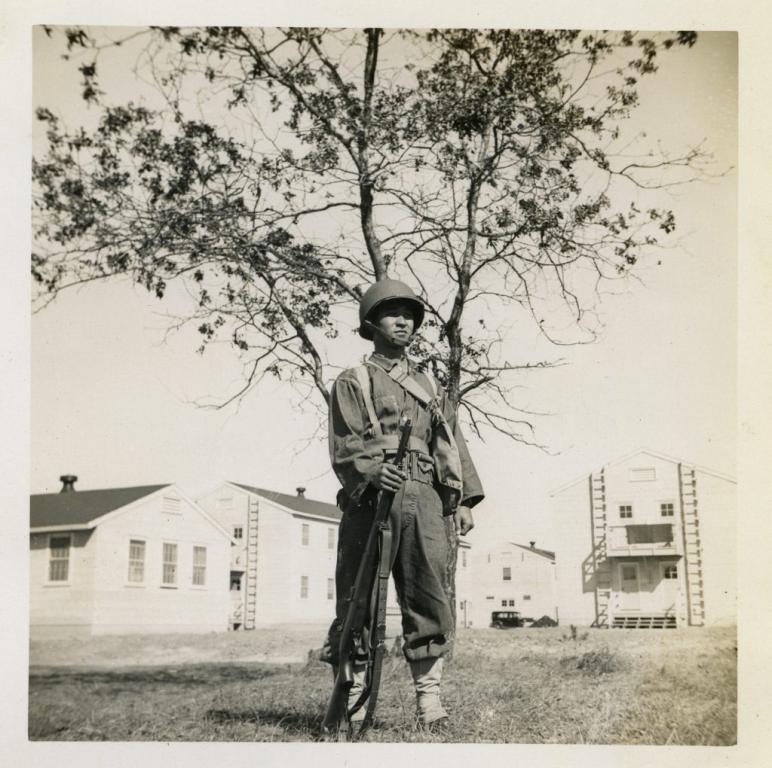-
Contributing Member


7 Aug 20 Garand Picture of the Day

MIS, Kazuo Yamane, was born on 8 December 1916 in the Kalihi neighborhood of Honolulu, Oahu, in the then U.S. Territory of Hawaii to a large family of eleven children (including four boys). After graduating from McKinley High School, where he participated in JROTC, in June 1934, he worked for his father’s business for a year before traveling to Japan to attend Waseda University in Tokyo. Because Yamane had Japanese citizenship (Yamane’s father registered him with the Japanese Embassy upon birth) in addition to American, he was required to serve in the Japanese equivalent of ROTC while at university. After graduating in June 1940, he returned to Hawaii two months later. He soon enrolled in the University of Hawaii on a part-time basis while returning to work for his father’s business. By late spring 1941, however, Yamane was forced to leave school to work full time as all the male employees of his father’s company had been drafted. Initially granted a deferment, Yamane eventually received his draft notice on 14 November 1941 and reported to nearby Schofield Barracks to begin his military service.
citizenship (Yamane’s father registered him with the Japanese Embassy upon birth) in addition to American, he was required to serve in the Japanese equivalent of ROTC while at university. After graduating in June 1940, he returned to Hawaii two months later. He soon enrolled in the University of Hawaii on a part-time basis while returning to work for his father’s business. By late spring 1941, however, Yamane was forced to leave school to work full time as all the male employees of his father’s company had been drafted. Initially granted a deferment, Yamane eventually received his draft notice on 14 November 1941 and reported to nearby Schofield Barracks to begin his military service.
On 7 December 1941, Yamane was home in Kalihi on a weekend pass when Japanese aircraft struck Pearl Harbor and other military installations on Oahu. His family home was close enough to Pearl Harbor that he could see antiaircraft shell bursts and heavy smoke billowing up from burning ships and airfields. Soon, radio reports went out ordering all military personnel to report to their posts immediately. Yamane donned his uniform and rushed to Schofield Barracks. During the drive, he witnessed aircraft attacking Pearl Harbor and saw several ships burning and sinking.
Upon reaching Schofield Barracks, Yamane and other soldiers were issued M1903 Springfield rifles and ammunition. Rumors of an imminent Japanese invasion and acts of sabotage by “fifth column” elements put soldiers and citizens on edge that first night. Soon, Yamane was assigned to Company E, 298th Infantry, Hawaii National Guard, which was stationed in a sector between Hauula and Kanehoe. From December until May 1942, Yamane served as part of a three-man machine-gun crew along the beach at Kahaluu. In addition to watching for an enemy invasion that never came, Yamane and his fellow soldiers spent many hours stringing up barbed wire along the beach.
More Here Kazuo Yamane The Campaign for the National Museum of the United States Army
Information
 |
Warning: This is a relatively older thread
This discussion is older than 360 days. Some information contained in it may no longer be current. |
|
He is no fool who gives what he cannot keep to gain that which he cannot lose
There are no great men, only great challenges that ordinary men are forced by circumstances to meet.
-
The Following 14 Members Say Thank You to Mark in Rochester For This Useful Post:
25-5,
30-06_mike,
Bill Hollinger,
Bob Womack,
CINDERS,
ed skeels,
frankderrico,
hoya74,
Jonzie,
lgr1613,
rayg,
RCS,
Sarge1998,
Tom in N.J.
-
08-06-2020 09:36 PM
# ADS
Friends and Sponsors

citizenship (Yamane’s father registered him with the Japanese Embassy upon birth) in addition to American, he was required to serve in the Japanese equivalent of ROTC while at university. After graduating in June 1940, he returned to Hawaii two months later. He soon enrolled in the University of Hawaii on a part-time basis while returning to work for his father’s business. By late spring 1941, however, Yamane was forced to leave school to work full time as all the male employees of his father’s company had been drafted. Initially granted a deferment, Yamane eventually received his draft notice on 14 November 1941 and reported to nearby Schofield Barracks to begin his military service.

















 PM
PM






